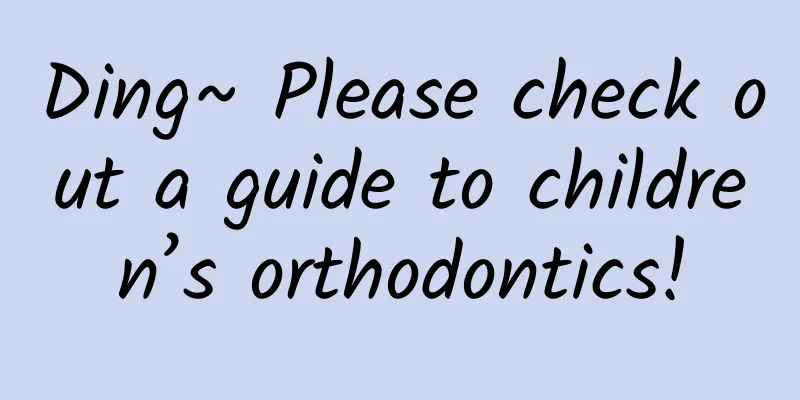Ding~ Please check out a guide to children’s orthodontics!

|
This is the 3795th article of Da Yi Xiao Hu May 15th this year is the 6th World Orthodontic Health Day. The theme of this year is "Appearance connects you and me, smile changes life". In recent years, parents have gradually realized the importance of children's oral health, and children's orthodontics have received more and more attention. Malformed dentition is not only unsightly, but also affects the future development of the child's maxillofacial region and the improvement of oral function. Today we will talk about several issues that parents are more concerned about in children's orthodontic clinics. 1. Are there many people with crooked teeth? The "uneven teeth" that everyone often mentions is actually one of the manifestations of malocclusion. Malocclusion refers to the misalignment of teeth, abnormal occlusion of the upper and lower dental arches, abnormal jaw size, shape and position, facial deformity, etc. caused by congenital genetic factors or acquired environmental factors during the growth and development of children. In China, the incidence of malocclusion in the permanent dentition period is about 72%, which means that seven out of ten people have uneven teeth. Fortunately, most of them can be corrected through orthodontic treatment. 2. How many methods are there for orthodontic correction? The correction methods that are more commonly used in clinical practice are fixed orthodontic appliances and bracketless invisible orthodontic appliances. The "steel braces" we often talk about in life are a type of fixed orthodontic appliance. The advantages of fixed orthodontic appliances are that they are widely applicable, easy for doctors to operate, and cheap. The disadvantages are that they have greater friction, may cause pain in the early stage of tooth arrangement, make brushing teeth and eating inconvenient, and are easy to irritate the oral mucosa. We often see that more and more people are choosing "transparent braces" for beauty. This is the bracketless invisible braces. The advantages of bracketless invisible braces are that they are invisible and beautiful, have almost no stimulation to the oral soft tissue, are relatively comfortable, can be removed and put on by oneself, and are easy to maintain oral hygiene. However, they require high initiative and execution, are more expensive than steel braces, have indications, and are not suitable for everyone. 3. How long does the correction process take? The time required for children's orthodontic treatment is related to the degree of tooth deformity. Early correction takes six months to one year, while permanent tooth correction takes about two years. In addition, it is also important to wear a retainer after the correction is completed, which generally takes two years or longer to effectively prevent rebound. As long as the child can cooperate well with the doctor, return to the doctor on time, maintain oral health, and protect the appliance, the efficiency of orthodontic treatment can be greatly improved. 4. Will the correction process be painful? In fact, children's tolerance is much stronger than you think. There will be some pain during the correction process, but children can tolerate it under normal and standardized operation. At the same time, every time the braces are adjusted, the teeth will feel sore, which is normal. 5. How much does the whole process cost? Different orthodontic plans require different costs. Generally speaking, the fixed correction cost of Shanghai public dental hospitals is 20,000-40,000 yuan, and the cost of invisible braces is 40,000-60,000 yuan. 6. What are the treatments? What are the precautions? 1. Since the braces cannot bear too much pressure, you should eat less hard, sticky and large foods during the correction process, and also give up bad habits such as biting pens and nails; 2. Reduce the intake of sweets and carbonated drinks during the correction period; 3. After each meal, you should use the correct brushing method to clean your mouth thoroughly, supplemented by oral cleaning products such as dental floss, to avoid the occurrence of caries, gingivitis or other complications. The above are some questions and answers about children's orthodontics. Dear parents and friends, once you find that your child has some dental problems, it is recommended to seek medical treatment from a regular dental treatment institution as soon as possible. Timely correction can minimize the adverse effects on tooth and jaw development, give your child a healthy set of teeth, and change your life with a smile! Written by: An Wentao, Huang Jie, Zhao Shengtao Reviewer: Liao Chongshan |
Recommend
Can pregnant women drink winter melon soup?
Speaking of wax gourd, it is a kind of vegetable ...
Should you add salt to steamed sea bass? Why don't you add salt to steamed sea bass?
As we all know, sea bass is a common fish food. T...
How much does pelvic floor muscle repair cost?
Once the pelvic floor muscles are damaged, they m...
What does Weibo Welfare Ji mean? Recommended famous Weibo Welfare Ji
What is Weibo Welfare Ji? Many people probably do...
Is yellowish brown vaginal discharge harmful?
Leucorrhea is a viscous liquid secreted by the fe...
The best way to treat interstitial blockage of the fallopian tube
Women may not be able to get pregnant due to fall...
Can I have a medical abortion at 38 days of pregnancy?
During the first month of pregnancy, women will e...
This action is really harmful to the body, but many people do it every day! Solution →
I believe everyone has heard that sitting for a l...
Serious consequences of abortion
For those who have an unexpected pregnancy, it is...
How to stimulate menstruation: Press your thumb
Not having a regular menstrual period can indeed ...
Yellow leucorrhea after miscarriage
With the development of today's society, peop...
How to treat vulvar warts?
In daily life, female friends must protect their ...
Specific methods for losing weight after menstruation
I believe everyone knows the importance of losing...
Are there any requirements for sleeping positions during pregnancy?
After the hard work in the early pregnancy, the f...







![[Medical Q&A] Does low back pain mean lumbar disc herniation?](/upload/images/67f0fe2fb7855.webp)

